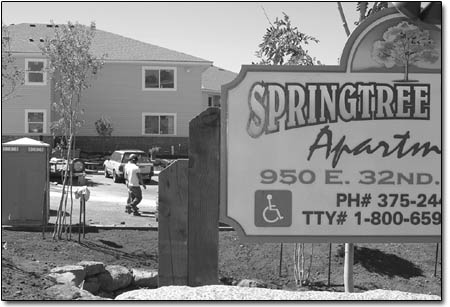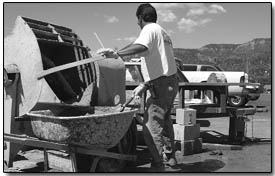 |
| The newly opened Springtree
Village apartments, at Holly Avenue and 32nd Street, has
added 28 units to Durango’s tight senior housing market.
However, Ken Ragsdell, manager of Springtree, said he expects
the complex to be filled by the end of the year. /Photo
by Todd Newcomer. |
(Editors’ note: Last week, the Telegraph
took a look at the homeless situation in Durango. This week,
coverage continues with a look at the local shortage of senior
housing.)
For more than 60 years, Jim Newman has lived in a tiny, ramshackle
house on the north end of East Third Avenue, where the walls
of his home hold memories of an older, different Durango. His
father built the house in the early 1940s. At the time, it was
one small room – now the kitchen – that housed the
family of six.
The green corrugated structure sits on four city lots, with
most of the land vacant. As decades have passed, surrounding
neighbors have upgraded or razed their homes, replacing them
with fancier ones.
Now, Newman’s security is being pulled from underneath
him like a rug. For the first time in his 73 years, he’s
confronting La Plata County’s scarce senior housing market,
and he’s not alone. Seniors throughout the county, along
with those who want to move here, are finding a shortage of
available apartments and, depending on the time of the year,
waiting lists that are months, if not years, long.
Boomer Boom
Newman lives on prime city property, the type homebuilders
are stumbling over each other to buy and develop. However, Newman
sold his family home to Albuquerque resident Doug Koss about
10 years ago and has been a renter since. A verbal agreement
between the two allowed Newman to live indefinitely in the house
for $600 a month in rent. Newman thought he had a good deal.
Then, two weeks ago, Koss told Newman that he sold the house.
Newman – who says he was unaware Koss was selling the
house – was told he had to move out by Sept. 2, at which
time a “bulldozer would be waiting.” The news stunned
Newman.
“I had no idea I would be faced with this situation,”
he says.
Visibly distraught, Newman shakes his head at the prospect
of homelessness. Repeatedly, he says he has no idea what he’s
going to do. On a fixed income –about $800 a month from
Social Security and retirement benefits – Newman says
he can hardly afford to enter the mainstream rental market in
Durango.
“This place has changed so much,” he says of Durango.
“It’s not the place where I grew up and you could
afford a place.”
Newman’s situation is not unique. Many managers of senior
housing complexes hear daily about the difficulty some seniors
on fixed incomes have when they move to Durango or sell their
homes. Unfortunately, these managers say, Durango isn’t
adequately prepared to take care of its senior population.
According to the 2000 U.S. Census Bureau, La Plata County’s
population increased from 32,284 in 1990 to 43,941 in 2000.
Of these residents, 5,714 are age 65 or older. During that 10-year
boom, low-income senior housing was scarce, says Don Burns,
manager of Tamarin Square Senior Living apartments. Burns says
seniors were waiting up to three years for a vacancy. Only recently
has that changed.
“Now our waiting list is short,” Burns says. “But
it’s impossible to guess how short ‘short’
is.”
Built in 1982, Tamarin Square is located in the 1400 block
of East Third Avenue and has 68 units, which are subsidized
– like most other low-income senior housing in the county
– with U.S. Department of Housing and Urban Development,
and Colorado Housing and Finance Authority money.
Late last year, Maine-based American Housing Preservation Corp.
bought the apartment complex and plans on spending several million
dollars in improvements.
Burns says currently, the opening of the 28-unit Springtree
Village apartments on East 32nd Street and Holly Avenue is easing
the senior housing climate. Many Tamarin Square residents are
moving to Spring Tree, but Burns said he expects any vacancies
to fill quickly.
Ken Ragsdell, manager of Springtree and the 24-unit Heritage
Village senior complex on Florida Road, agrees.
“Even with Springtree, there is a shortage,” he
said. “Springtree has a few vacancies, but I expect them
to be filled by the end of the year.”
Ragsdell said he receives constant calls from prospective tenants
and that during his four years as manager, there has always
been a waiting list of 10 to 15 applicants. Yet, an apartment
becomes available only about once a year.
“So85,” says Ragsdell. “There’s an
absolute need for more senior housing, even with new projects.”
Supply and demand
However temporary the senior housing crunch is, housing advocates
in the county believe the need will continue. Various studies
done by private consultants and public agencies have produced
differing results, though. This spring, Denver-based BBC Research
and Consulting prepared a housing needs assessment at the behest
of the city of Durango and La Plata County. The Colorado Division
of Housing provided grant money to complete the study, while
the state kicked in $15,000, and the city and county each kicked
in $7,500.
 |
Joe Torres, of Torres Construction, loads
cement into a wheelbarrow at the Springtree Village Apartments
on Tuesday. The opening of the 28-unit senior housing complex
is expected to ease the local senior housing
crunch, yet advocates of affordable housing say more needs
to be done for low- and fixed-income seniors./
Photo by Todd Newcomer. |
According to the study’s overview, city and county staffs
will use the study in deciding whether to support or fund affordable-housing
projects. While the study encompasses the entire housing market,
it includes a short section on senior housing that ultimately
concludes “there appears to be a limited need for additional
quality, affordable independent rental housing for seniors...”
However, the Department of Housing and Urban Development conducted
its own market research and analysis earlier this year and reached
a different conclusion. HUD officials deemed that there was
a shortage of affordable senior housing and consequently granted
money to a project being driven by the La Plata County Community
Development Corporation at East Animas Road and 32nd Street.
Bill Mashaw, the Community Development Corporation’s
chairman of the board, reports that construction on the first
30-unit phase of the project is slated for this fall, with a
spring completion date. The low-income units, mostly one bedroom,
will cost qualifying seniors $250 per month. The Colorado Division
of Housing and HUD are funding the $4 million project; the Volunteers
of America will manage it.
Mashaw says the project will not solve the senior housing problem,
though.
“It’ll make a major inroad,” he says. “The
second phase will include another 30 units. With all 60 units
built, only then it’ll have a major impact on this problem.”
Other affordable-housing projects will lend to the availability
of senior housing. Mercy Housing Corp. plans another major affordable-housing
project next year on Goeglein Gulch Road. Though the project
– Valle de Merced – will be available to all low-income
renters, there will be several one-bedroom apartments, which
often appeal to widowed seniors.
Mary Kennedy, community operations manager, says she frequently
hears from seniors who want an affordable one bedroom. Mercy’s
existing housing project, Merced de las Animas, has only five
one-bedrooms out of 50 units.
“And I haven’t had a one bedroom turn over since
1999,” Kennedy says.
She adds that Valle de Merced will have 46 units, with 17 one-bedrooms.
Kennedy says that some seniors seem to be aware of the shortage
of affordable housing because many of them are getting on waiting
lists now in order to have a place when they are ready to leave
their homes or move to the area.
“They are learning that they have to plan ahead in this
market,” she says.
Community builders
People like Newman, however, are finding this out too late.
Coupled with other expenses and a decrease in government services,
some seniors living here are being forced to choose between
rent, food or medication, says Sheila Casey, La Plata County
Senior Services program director.
Casey, who works with seniors daily, hears countless stories
about how increasingly expensive it is for those on fixed incomes
to survive in this county. Those who have been lifelong residents
are struggling to understand the new dynamics of a once-small
town. Others who want to move here to be near family are learning
it isn’t feasible.
“These are the most vulnerable people in our community,”
Casey says. “They built this community and it’s
time for the rest of us in the community to step up and give
them the support they need. It’s only a matter for a few
years before it’s going to get worse.”

